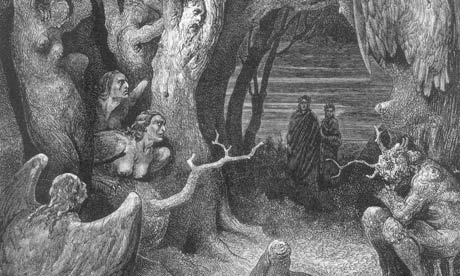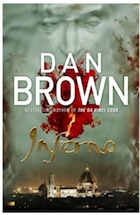Inferno by Dan Brown – review Infernal prose flows again from the bat-thronged belfry of Dan Brown's demented brain


Dan meets Dante: a Gustave Doré engraving of Dante’s Inferno. Photograph: Hulton Archive/Getty Images
I used to think that Dan Brown was merely bad. Now, after reading the latest version of the apocalyptic thriller he rewrites every few years, I suspect he might be mad as well. Inferno begins with the hero suffering from "head trauma", and Brown's head – a boggy hideout for the craziest superstitions of the so-called Dark Ages – seems to be similarly traumatised. He views creation as a cryptogram, and babbles about murderous albino priests, self-gelded ogres and a female devil who dresses in black leather and bestraddles a motorbike; he is fiendishly elated by the prospect of the world's imminent demise. Hogwarts Academy, compared with Brown's brain, is a clean, well-lighted, supremely lucid place.
Like a nutty magus, Brown smirks as his plots fast-forward human history to the last days, when we will all be raptured into annihilation by bombs, vials of antimatter particles or a lethal pandemic. "I am the Shade," the bioterrorist who menaces our species balefully croaks inInferno. "I am your salvation," he adds, although that salvation involves mass extermination. Brown reviles religion and treats earthly powers as a pious imposture. The trouble is that he aims to replace both sacred dogma and secular law with his own conspiratorial farrago.
The Da Vinci Code unveiled a heresy that was intended to capsize Christianity, Angels & Demons aimed a nuke at the Vatican, and The Lost Symbol revealed the government in Washington to be a coven of Freemasons practising sinister rites. Having disposed of God and denounced the rabid religiosity that has overtaken the United States, in Inferno Brown punishes the pullulation of our self-destructive species by threatening to unleash a plague: in his neo-medieval imagination a new strain of the Black Death is a surer way to control our numbers than rubbering up before sex.
As before, Armageddon is averted by the academic interpreter of symbols Robert Langdon. Previous novels sent Langdon on chases through Paris, Rome and Washington; now the same itinerary of shoot-outs punctuated by on-the-run iconographic lectures takes him across Florence, up to Venice, then to Istanbul. This itinerary soon exhausts all the available means of ground transportation, which justifies one of Brown's product placements – a smarmy ad for NetJets, an American company that specialises in "the luxuries of private air travel" and supplies CEOs with flying minicabs. Alternatively, characters cruise between locations in "a 237-foot luxury yacht… with a price tag of over 300 million US dollars" (Brown's writing may be ham-fisted but he knows how to tot up the zeroes).
Barmy as it is, I'm relieved to report that Inferno is also dreadful, abounding in malapropisms and solecisms, leaden restatements of the obvious and naive disinformation about the reality outside the bat-thronged belfry that is Brown's head. Words flatline, especially when he's trying to impress us with his cosmopolitan savoir-faire. Venice, we're told, is "one of the most spectacular and unique cities in the world". In a novel concerned with Renaissance art, I cherish Brown's notion that painters mix colours on a "palate" rather than a "palette": fancy a taste of azurite or ultramarine washed down by a swig of the Bombay Sapphire, Highland Park single malt or Gaja Nebbiolo that, in another flurry of commercial endorsements, the characters drink?
The clothes of these people are branded – Langdon changes out of Harris tweed into a Brioni suit, which in Brown's aspirational terminology is more "upscale" or "high-end" – but otherwise they're afloat in the ozone of a groundless imagination. Langdon professes the nonexistent discipline of "symbology" at Harvard, where Brown believes there are lectures on Saturday nights; the heroine is English but she addresses another female character, who is not the Queen, as "Ma'am".
The man who hallucinated this nonsense would be a harmless crank if he didn't have such a loyal, lucrative following. Like a demagogue, Brown panders to the mass mind with its craving for myths and monsters, and he preys on its credulity by claiming that the pseudo-science and muddled art history in his novels are "real". As if to prove the point, he adds actual people – his publisher (who has the precious NetJets corporate card) and a Florentine museum official – to his otherwise phantasmagoric cast; the mixture is not fiction but an intellectual fraud. Art at its best is a lie that tells the truth. At its worst, as in Brown's infernalInferno, it's a lie that expunges the truth and replaces reality with its own demented murk and noxious malarkey.

Comments
Post a Comment